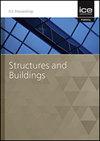Performance Assessment of Bamboo Bond Strength in Fly Ash Replaced Cement Mortar
IF 1.4
4区 工程技术
Q3 CONSTRUCTION & BUILDING TECHNOLOGY
Proceedings of the Institution of Civil Engineers-Structures and Buildings
Pub Date : 2022-10-10
DOI:10.1680/jstbu.21.00121
引用次数: 0
Abstract
The novelty of this study is on the combined experimental and statistical methodology-based approach, which is showcased to predict and optimise bamboo-mortar bond strength, incorporating the effect of various material factors affecting it. Design of experiments was used to quantify the impact of multiple factors affecting the bond strength. Firstly, different experimental pull-out tests were conducted in the laboratory to determine the effect of various factors such as water-cement ratio, curing days, cement to sand ratio, fly ash content and bamboo treatment on bond strength development. Three failure patterns, namely bamboo failure, bond failure, and failure of mortar, were observed. Secondly, using a two-level full factorial design method, different statistical models were formulated. These models (M1- Untreated, M2 - Both treated and untreated) were developed based on bamboo surface treatment. The effect of single factors and their interactions were quantified on bond strength development. The developed models were validated to predict bond strength based on different factors. It was concluded that the developed statistical models predicted and simulated the experimental behaviour of bond strength with sufficient accuracy.粉煤灰替代水泥砂浆中竹材粘结强度性能评价
本研究的新颖之处在于采用实验与统计相结合的方法,结合各种材料因素对竹砂浆粘结强度的影响,对竹砂浆粘结强度进行预测和优化。通过实验设计,量化了多种因素对粘结强度的影响。首先,在室内进行不同的试验拔砂试验,确定水灰比、养护天数、灰砂比、粉煤灰掺量、竹材处理等因素对粘结强度发展的影响。观察到竹材破坏、粘结破坏和砂浆破坏三种破坏模式。其次,采用两水平全因子设计方法,建立了不同的统计模型。这些模型(M1-未经处理,M2 -处理和未经处理)是基于竹表面处理开发的。量化了单因素及其相互作用对粘结强度发展的影响。对所建立的模型进行了验证,以预测基于不同因素的粘结强度。结果表明,所建立的统计模型能够较准确地预测和模拟粘结强度的实验行为。
本文章由计算机程序翻译,如有差异,请以英文原文为准。
求助全文
约1分钟内获得全文
求助全文
来源期刊
CiteScore
3.40
自引率
6.20%
发文量
61
审稿时长
12 months
期刊介绍:
Structures and Buildings publishes peer-reviewed papers on the design and construction of civil engineering structures and the applied research associated with such activities. Topics include the design, strength, durability and behaviour of structural components and systems.
Topics covered: energy conservation, people movement within and around buildings, strength and durability of steel and concrete structural components, and the behaviour of building and bridge components and systems

 求助内容:
求助内容: 应助结果提醒方式:
应助结果提醒方式:


